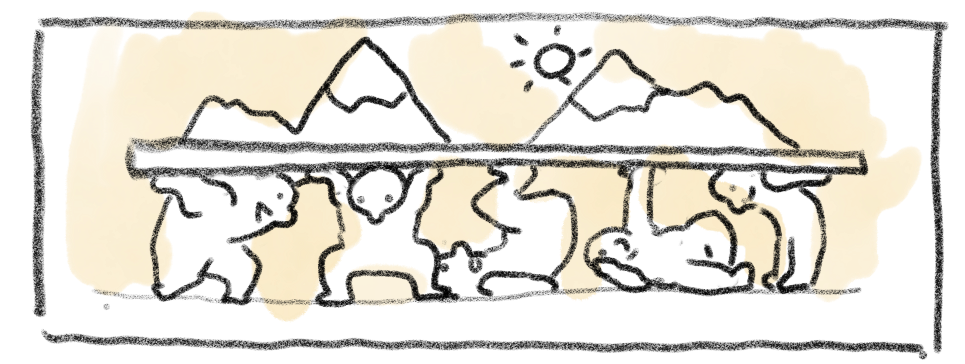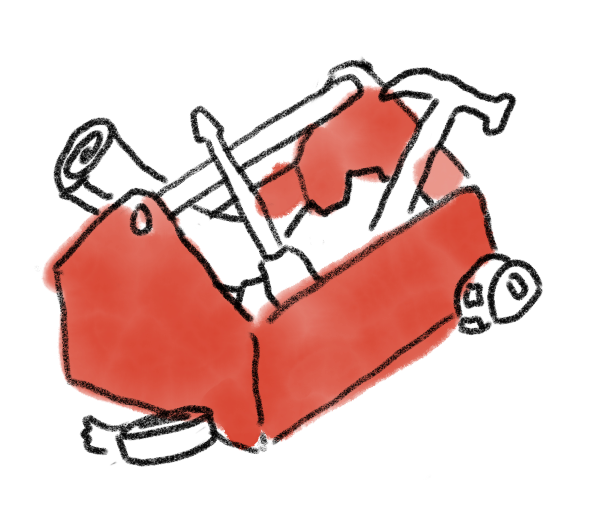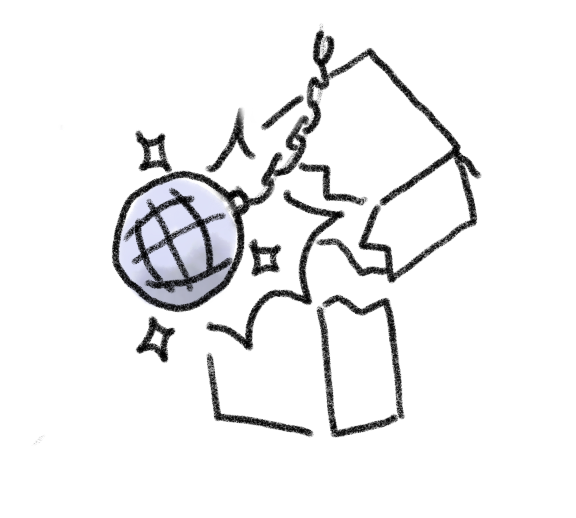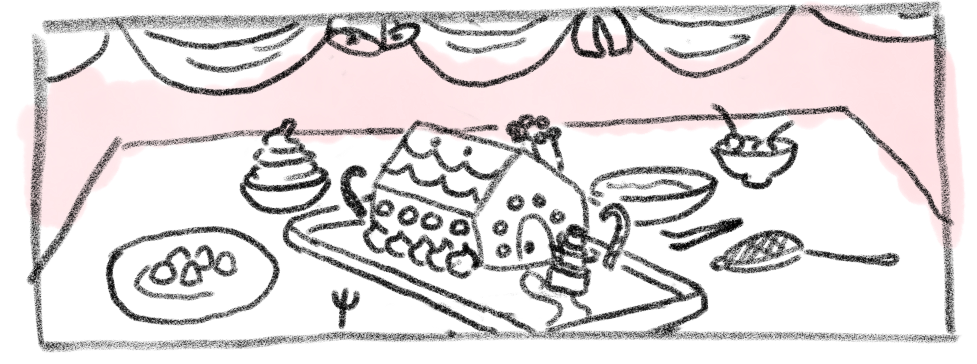Creative Project Management
Hyperlink is attempting to build tools for a new kind of project management!
Think about projects that feel like adventures. Projects where you discover what you're making as you go. Projects that evolve and even generate new projects along the way. Projects that feel like play.
We want to support creative project-making based in emergent discovery, anti-fragile process finding, connecting people — and above all, doing so in a way that's in service of fun and learning.
Quickly, what is a creative project?
A creative project is something ambitious and creative you do in your own time, usually without financial compensation. Such projects often (but not always) live within the context of a larger practice. For example, building a table is one project within a continued woodworking practice.
Some examples of creative projects might include:
- Learning a new language
- Starting and maintaining a garden (learning, digital, plant, or otherwise!)
- Participating in and publishing with a writer's group
- Running a workshop
- Making art or engaging in craft
While many creative projects have a population of one, we at Hyperlink are most interested in supporting projects with multiple members.
We find that having a social element to these projects encourages and inspires people not only to try new and interesting things, but also to plough on when their ongoing projects become difficult. Besides, it's just nice to have friends who share your interests!

How do we support creative projects?
For a long time, we at Hyperlink agonized over how we could make projects more "successful". We sought solutions that could help projects reliably run on schedule and achieve a high rate of completion. Over the last few years we considered a host of things that we thought might help people start projects, stay on track, and complete what they set out to do, for example:
- Writing down goals and intended artifacts of a project before starting
- Roadmapping milestones and sending reminders when important dates were coming up
- Timeboxing projects to defined start and end dates, and automatically marking them complete once those dates passed
- Systems for assigning tasks so that members of a group always knew what they were responsible for and when each task was due
But every new invention aimed at reining in procrastination and trying to motivate a tired project felt restrictive, came with high start up costs, and most importantly, had bad vibes. Using it felt like work. So we revisited what we've learned from our community and our own experiences.
In talking to people who love to do creative projects, and in doing our own projects in Hyperlink, we found that while people certainly do sometimes define success based on completion or consistency, they often find more fulfillment and learning in other aspects of the process, like:
- Gaining or honing a new skill, even if that skill was not the one they had intended to obtain when they started
- Being part of an excited community of people working on similar things
- Being intrinsically motivated to continue a project, and thriving in a structure they tailored to their own needs
- Not feeling obliged to continue something they no longer wanted to do, whether that means evolving in a new direction or simply ending the project for now
We were especially struck by the sheer variety and nuance in every person's process. Even though many people used the same tools…
- text editors: Google Docs, Roam, Notion, good ol' pen and paper
- file managers: Dropbox, Google Drive, a stack of papers
- social media: Discord, Twitter, Instagram, text messages
- project management software: to do apps, kanban boards
…they had each jerry-rigged unique ways that these tools worked together. These were processes they built for themselves over years, tweaked lovingly to reflect their motivations, situations, and personalities.

Hyperlink as a work surface for discovering structure
We like to think of the app as a good workbench. Workbenches, writing desks, painters easels, kitchens, code editors, and other places of creative work are constantly built, rebuilt, tinkered with, and molded to suit the creative processes of their users.
Since our processes and tools are always changing, so are the sites and surfaces of our work. We're building Hyperlink to be a fluid and malleable surface, where it is possible to — casually or formally — invent and reinvent creative process.
In service of being the ideal internet workbench, some core design values come to mind:
- Provide space for exploration, slowness, meandering, and intentional un-intention
- Be a flexible place that can grow to suit your needs
- Facilitate conversation that is rooted in particular context but is also serendipitous and friendly
- Remove feelings of "failure", "disappointment", and "obligation", and replace them with "the spirit of adventure", "play", and "coziness"
What does that actually look like?
Enough wild gesturing and star gazing! How are we gonna pull off this (admittedly pretty grand) claim?
I'm sure we'll keep expanding our ability to acheive these aims, but here are some of the strategies we've come to rely on so far.

Kit of Parts
We can talk all day long about assembling tools into process, but we won't get very far without tools to start out with.
Luckily, as I mentioned before, most project-doers use similar sets of tools. We are building a suite of tools that we think will meet the needs of a wide range of creators. Importantly, we're building these tools to serve common functions more so than specific use cases.
-
cards are places to put a bunch of content, but we don't suggest that you have to use them for notes, or outlines, or ideas, or images — they can be for all these things and more
-
rooms help you organize cards, spatially and in filterable lists, but we dont decide what they're used to organize — they can be collages, progress logs, to do lists, mind maps, even little games
-
chats/comments let you make statements ordered in time — they can be for conversations with collaborators, quick feedback, writing yourself reminders, making annoucements, and so on
-
presence gives you ways to feel other people at work beside you — great for casual hang outs, planned calls, serendipitous moments, and other situations where it's nice to be in a shared space together
Using tools that don't heavily suggest their intended use can at times be overwhelming. But we think this initial difficulty is worth it for the freedom it offers to build something that really works for you. We'd rather provide you with a blank notebook than a pre-structured planner.

The Spatial Analogy
Our most flexible and well understood metaphorical framework for organizing things is IRL space.
You can organize a deck of playing cards into a thousand different games, or rearrange furniture to configure a living room for a totally different use. We each have an incredible amount of unspoken assumptions about how we interact in physical space. As a result, there is no other medium we manipulate with as much ease and variety as our physical environment.
Hyperlink leans on spatial analogy so that we can borrow this power. We conceptualize nuggets of information into cards that can be "placed" in rooms or on other cards. We minimize instances where an algorithm might automatically organize things for you, so that you always know where you "left" something. Everything is draggable, to really drive home that you "put" something in a particular place.
Imbuing spatiality on the computer screen is one of my favorite topics — one day I'll write a whole other blog post about this!

Minimum Viable Refactor
It is always possible to undo, redo, refactor, and rearrange things in Hyperlink.
Elements of any list can be dragged to reorder. Anything can be renamed or removed in a couple of clicks. The same card can be in multiple places, so you dont have to decide on a single place where you want it. We recently redid our card search so that you can look up a card from anywhere and plonk it down where you need it.
Making it as easy as possible to change things allows you to experiment cheaply with different workflows. When it's easy to evolve, tweak, and even completely overhaul, its more possible to change tack and try again.

Project structures (or non-structures) that are possible in Hyperlink
A project with clear goals and a clear plan that you follow to the letter in a timely way
You CAN plan something with precision and purpose! We started out as a course platform, a place for facilitated, curriculum-driven, deadline-oriented learning. We continue to see value in having a plan and goals clearly laid out in from the get go.
But the Hyperlink app has as few assumptions as possible around what that rigid structure should be. Weekly meetings with homework in between? Daily reflections with a large project at the end? Completely async, with projects or worksheets you do at your own pace? It's your choice, Hyperlink just enables it!
Starting a project with a clear plan and goal, but getting distracted by something way more fun in the middle
One of the joys of creative projects is that things don't have to go according to plan.
For more exploratory projects, a Hyperlink Space can facilitate happy accidents and new paths of discovery. Often, the best projects grow over their lifetimes into something completely unexpected and new.
Starting a project with a general goal, and no other plans
It's also great to just wing it, figuring things out as you go along!
We've found that Hyperlink Spaces often fluctuate between messy and organized. While we are thinking, discovering, and exploring initial project ideas, we move fast and try on many structures and frameworks to organize ourselves. When we settle on something that works, we refactor the Space neatly to better facilitate that workflow going forward.
A project can be a series of experiments, where you start with a hypothesis and figure out how to test it in many different ways as it evolves over time.
Having many incomplete projects, or project ideas that you never revisit
In our research, we found that many project-doers have a lot of anxiety around never completing projects, or love to plan projects but are dismayed that they don't always execute them as planned.
In Hyperlink, completion is just one of many ways that projects can be successful. It's still possible to feel proud of work you didn't complete. Maybe you learned something valuable. Maybe your project died but later on contributed to a much cooler new project. Maybe a long list of projects-that-could-have-been is an interesting and worthwhile endeavor in and of itself.
Projects that feel like homes you can return to
Sometimes a Space represents not one well-defined project but a family of projects — the line can blur between this sort of project ecosystem, and an ongoing practice that you return to again and again.
These kinds of spaces can feel like a cozy home, kitchen, workshop — a familiar place with familiar mise en place, where you can pick up where you left off and continue old threads.
Doing a project that takes a reeeeeeaaaaaally long time
You might have some Spaces you update every day, and other Spaces you only visit once a month or once a year. Either way, you can layer your thoughts into them over time, like coats on an oil painting.
In Conclusion
We're excited to explore new paradigms for doing projects, ones that embrace the chaos and emergence of how creative work actually works.
In building Hyperlink, we want to help with the hard parts:
- flexible work surfaces that make space for discovery
- affordances for fluid, emergent process
- systems for creative pathfinding and sensemaking
- collaboration as constant negotiation via conversation
- cozy homes that suit each project's unique needs and vibes
Why? It's simple: we want more great projects to exist and thrive.
Projects that generate amazing creative work and ambitious learning experiences. Projects that are fun, meaningful, and aligned with your values. Projects that resonate with others — often the best way to keep that initial spark of energy alive.
If we can build a useful alternative to the chaos and exhaustion of the prevailing social media landscape — online social spaces that feel regenerative rather than depleting — well, that's an added bonus!
If you have a project that doesn't neatly fit into files and folders, to do lists and task managers, we'd love to have you give Hyperlink a try.
We've started with things like cards (to flexibly represent anything), rooms (to organize cards in malleable structures), and comments (to talk about anything). But it's early and there's a lot more we can do — let us know if you have ideas!